Part one: The boy wonder who became the world’s best
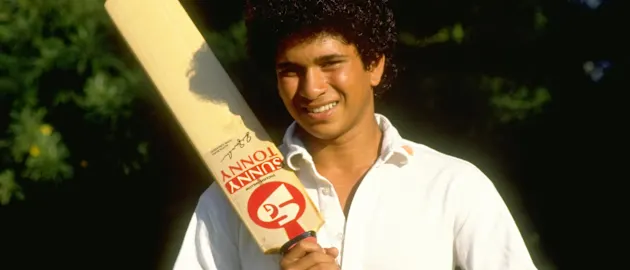

In part one of this career retrospective, we track his path from school batting phenom to ICC Cricket World Cup record-breaker.
A RECORD BREAKER FROM THE GET-GO
Even in the early years of being a teenager, there was a hype around Tendulkar and that only grew as he dominated the Harris Shield in 1987/88 for Shardashram Vidyamandir school. He scored 1025 runs across five matches in the Under-16 tournament.
Of those, 326 runs came in one famous knock, in which he combined with future India teammate and close friend Vinod Kambli in a record-breaking 664-run stand.
For 18 years it stood as the biggest partnership at any level in cricket history, only eclipsed in 2006 by two 13-year-olds in Hyderabad.
“That partnership was the turning point of our careers. It changed our lives and opened the floodgates for our selection into the Mumbai and Indian team,” Kambli told DNAin 2018. “Once we got into the groove, Tendlya (Tendulkar) and me toyed with the attack. After every boundary and six, we would sing Wham!’s Wake me up before you go.”
It’s a moment in time that Tendulkar still looks back on fondly, tweeting last year: “Doing what we loved the most. Remember that partnership quite vividly my friend.”
Doing what we loved the most. 🏏
— Sachin Tendulkar (@sachin_rt) February 26, 2020
Remember that partnership quite vividly my friend. https://t.co/JAmCr0aQZI
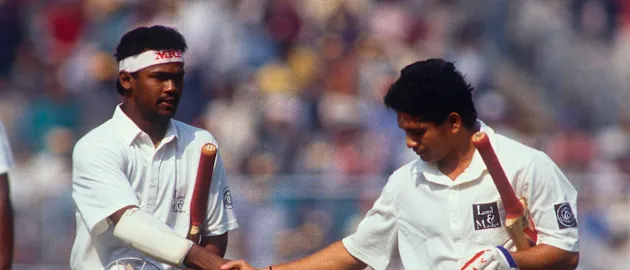
DOMINATING DOMESTIC CRICKET
Having made waves in school cricket, a 14-year-old Tendulkar was added to Mumbai's squad for the 1987/88 domestic season, missing out on sharing a dressing room with his idol, Sunil Gavaskar, by mere months.
Tendulkar would not play a game that campaign but the time spent learning around the group paid dividends when his chance to play came the following season.
Aged 15 years and 232 days, he debuted for Mumbai in the Ranji Trophy after impressing captain Dilip Vengsarkar in a net session against the India team, who were preparing for a Test against New Zealand. Walking out to bat in the No.4 position he would become so synonymous with in Test cricket at Wankhede Stadium, Tendulkar eased his way to an unbeaten 100 off 129 balls, hitting 14 boundaries along the way.
He would go on to score 583 runs at 64.77 that Ranji Trophy season, and followed that up with a century for the Rest of India team against Delhi in the Irani Cup. Two years later, after he had already announced himself on the international stage, he notched another debut ton in the Duleep Trophy.
In doing so he became the first player to ever score a century on debut in all three of India’s domestic first-class tournaments.
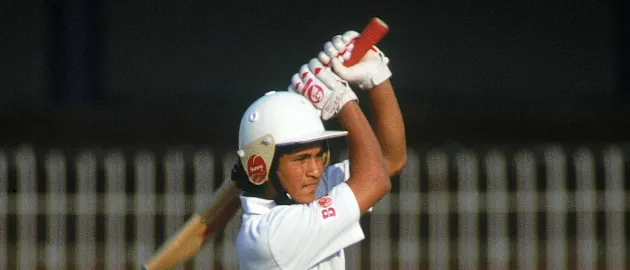
DEBUTING AGAINST IRMAN, AKRAM AND YOUNIS
Having excelled on the first-class stage, Tendulkar was called up to play Test cricket for the first time in 1989.
Still four months short of his 17th birthday, the diminutive right-hander was picked to play in Karachi against a Pakistani outfit featuring Imran Khan, Wasim Akram and Abdul Qadir.
Tendulkar would only manage 15 runs for the match, falling to another man making his debut in Waqar Younis.
But the runs would start to flow from the second Test onwards. He notched a half-century at Faisalabad, and followed it up with 41 in Lahore. It was in the fourth Test at Sialkot that he proved age would be no barrier.
With India in deep trouble at 38/4 in their second innings, with a day and a half’s play still remaining, Tendulkar was under pressure from the outset. Just one run into his innings, he misread a short ball from Younis and wore it on the nose via a deflection off his helmet.
Blood gushed from his nose to stain his shirt red. On the field, Javed Miandad suggested he go to the hospital for a broken nose. In the stands, a banner informed him to go home and drink milk. Instead, the teenager batted on.
He got through to stumps and continued into day five, scoring a brave 57 off 134 before falling to Imran as India held on for the draw.
It was a performance he would look back on at several junctures in his career.
Two legends, one beginning – Sachin and Waqar
OnThisDay in 1989, legendary India batsman Sachin Tendulkar and Pakistan's bowling gem Waqar Younis made their Test debuts in Karachi.
FINALLY A MAIDEN TON
Tendulkar finished his career with an incredible 100 hundreds in international cricket. That’s one every 7.82 innings.
It took him until his 21st international innings to notch the first of those centuries, having passed 50 four times on his way there.
In his 10th innings and just his sixth Test, he had missed the chance to become the youngest player to ever score a Test century, perishing for 88 against New Zealand at Napier. He was caught at mid-off by New Zealand captain John Wright off the bowling of Danny Morrison, and was in tears by the time he reached the boundary ropes. He would later joke to Wright, when the Kiwi became India’s men’s coach, that he should have dropped the catch.
Six months later, Tendulkar would not let his next chance at a century go begging.
Coming out to bat with India in trouble on day five at Old Trafford against England, he enjoyed an early life when he was put down on 10 by Eddie Hemmings. He made the most of the chance, going on to raise his century on day five.
“There it is – a Test match hundred for Tendulkar,” Richie Benaud’s iconic voice rung out in commentary. “Aged 17 years and 112 days. One of the youngest ever to get a Test match hundred. An innings of temperament, skill and delightful stroke play.”
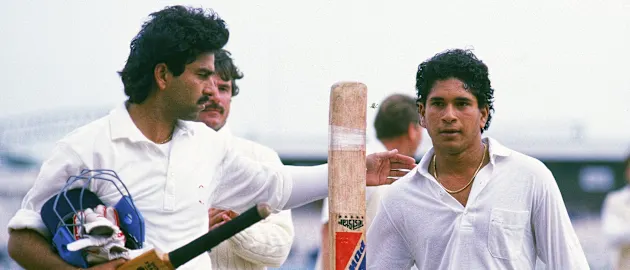
THRIVING DOWN UNDER
Tendulkar had missed out on the record for the youngest batter to score a Test century, but he did manage to become the youngest player to score a hundred in the format in England.
He then did the same in Australia in 1992, scoring centuries as an 18-year-old at the Sydney Cricket Ground and the WACA. It was a campaign he later credited for changing his career.
The first ton – in a match where a certain Shane Warne debuted – started a love affair with the SCG that would span 20 years and five Tests, across which he would average 157 and score three centuries, including one double.
But it was the second hundred that really caught the attention of the cricketing world. Against an Australian attack spearheaded by Craig McDermott and Merv Hughes, on a spicy WACA surface that had proved too hot to handle for his seasoned teammates, he scored a 161-ball 114 as India were bowled out for 272.
“One innings that changed my career or gave shape to my career was in Perth, 1992,” Tendulkar was quoted as saying by the Press Trust of India in 2014. “Perth, at least at that time, was regarded the fastest wicket, and the hostility of the Australian fast bowlers was something that was difficult to handle.
“I knew that Perth was the kind of wicket which I would not get to play anywhere in the world and If I can bat on Perth and score runs then I am possibly equipped to go on any other track which is fast and bouncy and score runs there.
“My career was just starting. I had done well for a couple of years by then but it really took off after that Perth innings because I felt I was ready to take on the world.”
Or, as Hughes put it more succinctly in 1992 in the dressing rooms at the WACA over a beer with captain Allan Border: “This little pr**k's going to get more runs than you, AB.”
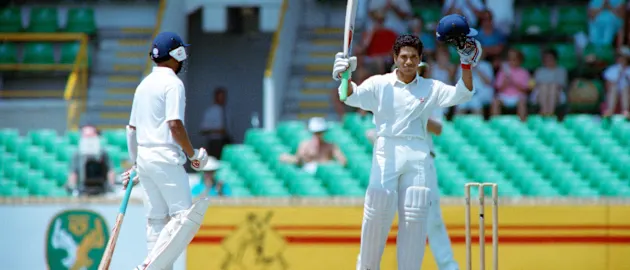
THE PATH TO ODI GREATNESS
Tendulkar scored his first Test century in 1990. His first ODI ton did not come until 1994 in his 79th match in the format.
The century, scored against Australia in Colombo, came shortly after his promotion to the top of the order in ODI cricket – a position he and Sanath Jayasuriya would reinvent through the 1990s.
Opening the batting for the first time in March 1994 against New Zealand, Tendulkar had blasted a rapid 82 runs off 49 balls. That is a strike rate that remains impressive today, let alone in the mid-90s.
However, the maiden ODI ton against Australia was a more restrained 110 off 130 in a 31-run victory.
It was the start of greater things for the Indian icon, who averaged 32.70 in ODIs before the century and 47.10 after it.
A GOLDEN PERIOD
Singling out any portion of Tendulkar’s career for special praise is close to impossible. Part of the Little Master’s aura was the infrequency with which he truly endured lean patches. A great performance was seemingly always just around the corner.
Nevertheless, the second half of the ‘90s and early 2000s are worth special mention.
In 1996 he topped the World Cup run-scoring charts for the first time, tallying 523 runs at an average of 87.16. He was the lone batter to make more than 500 runs in the tournament. He notched the first two of his six career World Cup centuries that year, scoring 127 against Kenya and 137 against eventual champions Sri Lanka. There were three fifties outside of that, including a 90 against Australia and 65 in a semi-final loss to Sri Lanka.
In 1997 he scored 1000 Test runs in a calendar year (1000 at 62.50) for the first time, raising four centuries.
In 1998 he put Australia to the sword in the Border-Gavaskar Trophy, scoring 446 runs at 111.50 as he dominated a series that had been billed as a battle between himself and Warne. Two centuries and a fifty across the three Tests in India painted a clear picture of who came out on top this time around.
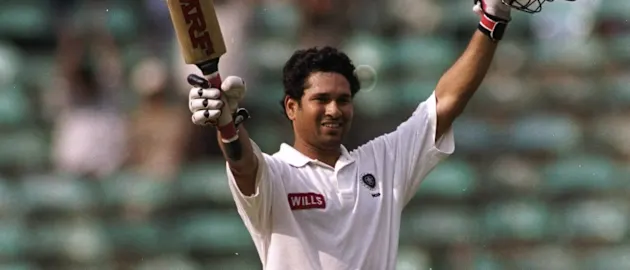
He continued his dominance of the Australians at the Coca-Cola Cup the same year, producing two of the most memorable innings of his career. In India’s final match of the group stage against Australia, he blitzed 143 runs in 131 balls in an innings that would be known from then on as Desert Storm after the match was interrupted by a sandstorm. The century wasn’t enough to earn India victory but it did secure them a spot in the final ahead of New Zealand via net run rate. In the final, he scored another ton, making 134 off 131 balls to steer India to a six-wicket win.
Indeed, 1998 was a special year for Tendulkar in which he scored 647 runs at 80.87 in Test cricket and 1894 at 65.31 in ODIs. That remains the record for the most ODI runs in a calendar year, while his 12 international centuries for the year still stands as the benchmark.
In 1999 he enjoyed his most productive year in Test cricket up to that point (1088 runs at 68, five centuries) and stepped up with one of the bravest performances of his career. Already battling a bad back at the World Cup, Tendulkar was rocked by the news of his father’s passing. After four days back home in India, he returned to London the day after the funeral to score a brilliant and unbeaten 140 off 101 balls against Kenya.
By 2002 he went past Don Bradman’s Test century haul, scoring his 30th in his 99th match for India.
Across the six years between 1997 and 2002, he scored 17 Test and 23 ODI centuries, with a lowest calendar year average in Test cricket of 55.68.
The lone sour note in this period for Tendulkar and India were two broadly unsuccessful stints as captain.

THE 2003 WORLD CUP
The year 2003 was one of two halves for Tendulkar, but they weren’t split chronologically so much as they were by format.
In Test cricket he found himself underperforming for the first time in his career, enduring a lean patch by anyone’s standards, let alone his, averaging 17 across his five matches for the year.
In ODIs however he seemed to be walking on water, and it was at the 2003 World Cup that he was at his very best. Across 11 matches he scored 673 runs at 61.18, setting a new record for the most runs in a single World Cup campaign as he inspired India to just their second final.
His high score for the tournament came against Namibia, but his best performance was undeniably against Pakistan in a match so big it had taken on a life of its own. Such was the hype surrounding the game that Tendulkar struggled to sleep for the three nights leading into it.
With Waqar and Wasim in tow, Pakistan already had one the most formidable pace attacks in the world, but it was speed demon Shoaib Akhtar who loomed as their biggest threat.
Set a target of 274 to win, Tendulkar had told opening partner Virender Sehwag that they should take some time getting themselves in before taking the attack to Pakistan. What transpired was very different.
The pair picked up nine runs off the first over from Akram but it was in the next over from Akhtar that Tendulkar really took it up a gear in an over that brought India 18 runs. On the quick’s fourth ball, Tendulkar produced one of the most iconic shots of the tournament, slashing him over third man for six. The next ball was dispatched behind square for four and the final delivery of the over was met with a simple prod timed so well it raced along the carpet for another boundary. It turned out to be a one-over spell for Akhtar but his removal from the attack did little to quell India, who raced past 50 in the first five overs.
He went on to make 98 off 75 that match, eventually perishing to Akhtar but there could be no mistaking who the winner of this contest was.
Sachin Tendulkar smashes 98 against Pakistan, surpassing 12,000 ODI runs
ICC CWC 2003; Pakistan (273-7) v India (276-4). India won by 6 wickets
India cruised through to the final from there but World Cup glory would evade them as Australia wrapped up their second consecutive tournament win.
Few players in the world have ever been as hard workers in the nets as Tendulkar but incredibly he took a very different tack throughout the 2003 tournament.
“In the 2003 World Cup, Sachin Tendulkar didn’t bat a single ball in the nets, right through the tournament. He only got throw-downs. He just received hundreds of throw-downs through the whole tournament,” Rahul Dravid revealed in 2014.
“All of us were wondering ‘Why is he doing that?’ When I asked him, he said, ‘I’m feeling good. I don’t want to go into the nets and waste the touch. I want to feel good about my batting. If I have that sort of feeling, I will score runs when I go in”.
